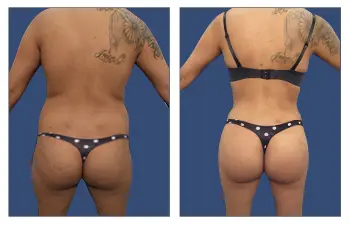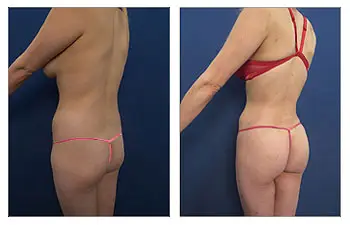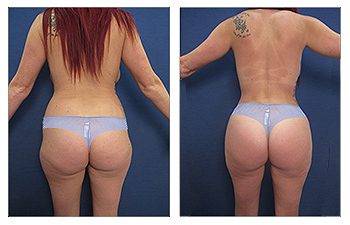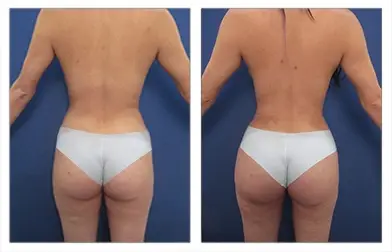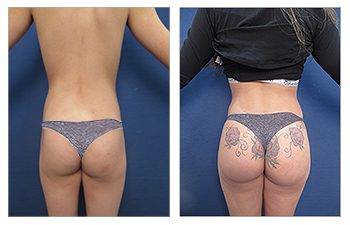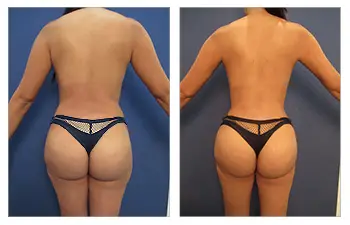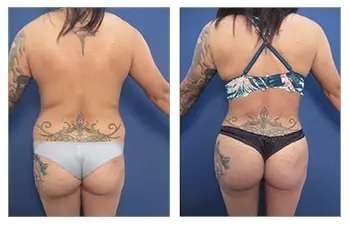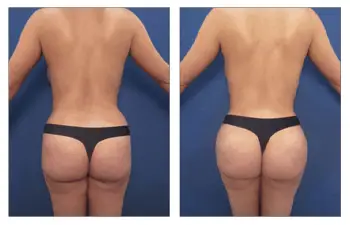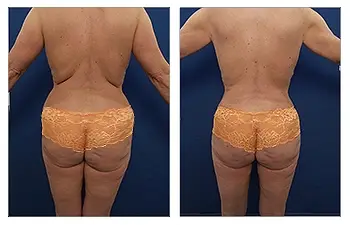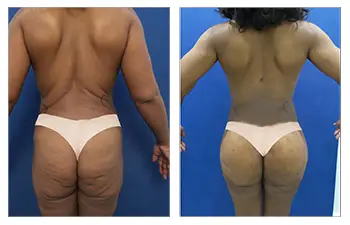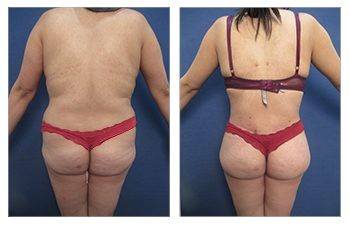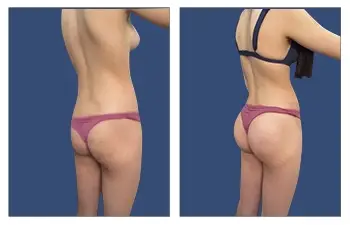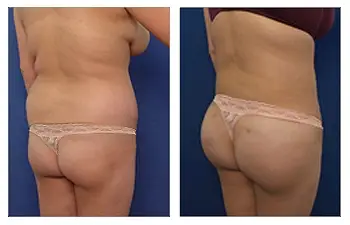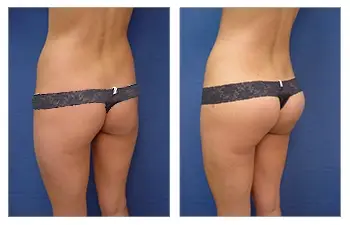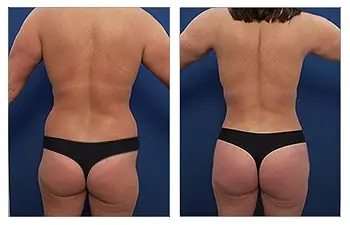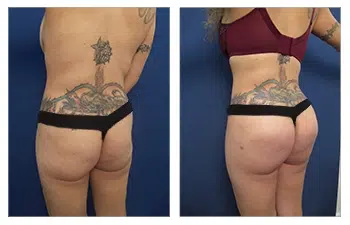Introduction: BBL Complications Years Later
Brazilian Butt Lift (BBL) surgery, like any plastic surgery, comes with potential long-term risks and complications. These may include fat embolism, skin irregularities, asymmetry, chronic pain, and long-term dissatisfaction with the results. Fat embolism, where fat enters the bloodstream and blocks blood vessels, is only a complication risk in the early postoperative period. Skin irregularities and asymmetry may become more evident as the body changes over time. Chronic pain and dissatisfaction with the results may require further intervention or psychological counseling.
Warning signs to watch for years after BBL surgery include persistent pain, lumps or areas of hardening around the buttocks, changes in the appearance of the buttocks, and any signs of infection. It’s important to stay in contact with the surgeon who performed the procedure and seek medical attention if any concerning symptoms arise. It’s crucial for individuals considering BBL surgery to fully understand the potential complications that may arise in the long term and carefully weigh the risks before undergoing the procedure.
What Will Happen To My BBL Results in 5 Years?
After 5 years, it is common for BBL results to undergo potential changes due to natural aging, weight fluctuations, and the settling of transferred fat. To maintain the best long-term outcomes, it is essential to follow a healthy lifestyle, including regular exercise and a balanced diet. Weight management is crucial as significant weight gain or loss can affect the appearance of the BBL results. Additionally, regular body contouring treatments and massages can help ensure that the new curves continue to look their best.
It is also important to avoid prolonged sitting or pressure on the buttocks to prevent fat displacement. As part of the maintenance, touch-up procedures may be needed to address any decrease in volume or asymmetry. Regular follow-ups with a board-certified plastic surgeon will also allow for monitoring of the BBL results and guidance on any necessary adjustments. Overall, maintaining BBL results requires diligent care and attention to ensure the best long-term effects.
What Will Happen to My BBL in 10 Years?
As the popularity of Brazilian butt lifts (BBLs) continues to rise, many individuals are curious about the long-term effects of the procedure. With advancements in medical technology and techniques, it’s important to understand what could potentially happen to your BBL in 10 years. From changes in fat graft retention to the aging process of the body, this article will explore the potential outcomes and considerations for individuals who have undergone a Brazilian butt lift. Understanding the longevity of your BBL can help you make informed decisions and maintain realistic expectations for the future.
How To Minimize BBL Complications Years Later
To minimize BBL complications years later, it is essential to be aware of the potential risks such as fat necrosis, asymmetry, infection, and contour irregularities. Regular follow-ups with your plastic surgeon are crucial to monitor any changes and address any concerns that may arise. These follow-ups allow the surgeon to assess the long-term results of the procedure and make any necessary adjustments to ensure the best possible outcome.
In addition to regular follow-ups, maintaining a healthy lifestyle can help minimize the risk of complications. This includes following a balanced diet, engaging in regular exercise, and avoiding smoking and excessive alcohol consumption. It is also important to practice proper weight management to ensure the longevity of the BBL results.
Furthermore, taking precautions such as avoiding prolonged sitting on the buttocks and using supportive cushions when sitting can help reduce the risk of fat necrosis and contour irregularities.
By staying diligent with follow-up appointments, adopting healthy lifestyle habits, and taking necessary precautions, the risk of BBL complications years later can be minimized, allowing for long-lasting, satisfactory results.
Don’t Smoke
To ensure the longevity of your BBL results, it is crucial to avoid smoking and second-hand smoke. Smoking can have a detrimental effect on the oxygen flow and nutrient absorption in the treatment area, leading to compromised results. When you smoke, the carbon monoxide in cigarette smoke reduces the amount of oxygen that your blood can carry, which can impede the body’s ability to heal and regenerate tissue. This can negatively impact the success of your BBL treatment and hinder the desired outcome. Additionally, smoking can constrict blood vessels, reducing the flow of nutrients to the treated area, and further compromising the results of the procedure.
To avoid these negative effects, it is essential to refrain from smoking and also steer clear of environments where you may be exposed to second-hand smoke. By doing so, you can ensure that the oxygen flow and nutrient absorption in the treatment area are optimal, allowing for better healing and enhanced results. By following these recommendations and avoiding smoking and second-hand smoke, you can help to safeguard the longevity of your BBL results.
Don’t Sit On Your Butt for Long Periods
After a Brazilian Butt Lift (BBL) procedure, it is crucial to avoid sitting for long periods to ensure the survival and optimal retention of the transferred fat cells. Prolonged sitting can put excessive pressure on the buttocks, which can potentially compress and damage the newly transplanted fat cells, compromising the results of the procedure.
To minimize pressure on the buttocks when sitting, it is recommended to use specialized cushions or pillows specifically designed for post-BBL recovery. These cushions help distribute the weight evenly, reducing the pressure on the buttocks and supporting the healing process. Additionally, sitting on a donut-shaped cushion or leaning forward onto your thighs while sitting can also help alleviate pressure on the buttocks.
By taking these precautions and avoiding prolonged sitting, you can help maintain the results of your BBL procedure and ensure the long-term success of the fat transfer. It is important to strictly adhere to the sitting restrictions and utilize appropriate cushions to support the healing and retention of the transferred fat cells.
Always Hydrate
Staying hydrated is essential for maintaining optimal health. The recommended daily water intake for adults is approximately 11.5 cups for women and 15.5 cups for men, although individual needs may vary based on factors such as activity level and climate.
Dehydration occurs when the body doesn’t have enough water to function properly. Common signs of dehydration include thirst, dry mouth, headache, dizziness, and dark yellow urine. It’s important to drink enough water throughout the day to prevent these symptoms and maintain overall well-being.
Drinking enough water has numerous health benefits, including improved energy levels, better concentration, and enhanced physical performance. Proper hydration also supports healthy digestion, kidney function, and skin health. In addition, staying well-hydrated helps regulate body temperature and can prevent muscle cramps during physical activity.
Overall, staying hydrated is crucial for overall health and well-being. By meeting the recommended daily water intake, individuals can experience a range of benefits, from improved energy and concentration to better physical performance and overall wellness. Always remember to prioritize hydration as a key aspect of maintaining good health.
Eat A Healthy and Balanced Diet
After undergoing BBL surgery, maintaining a healthy and balanced diet is crucial for the healing process and long-term results. A well-rounded diet that includes nutrient-rich foods such as fruits, vegetables, lean proteins, and healthy fats can promote overall health and aid in the recovery process. It is essential to stay hydrated by drinking plenty of water and avoiding sugary and caffeinated beverages. Additionally, avoiding smoking is important as it can hinder the healing process and affect blood flow to the buttocks.
A balanced diet and healthy lifestyle can also promote skin health and support healthy blood flow to the buttocks, which is essential for the longevity of BBL results. Specific foods that can aid in the healing process after BBL surgery include avocados, salmon, butter, olive oil, coconut oil, and walnuts. These foods are rich in essential nutrients, healthy fats, and antioxidants that can support the body’s healing process and overall health.
In summary, maintaining a balanced diet and healthy lifestyle is essential for optimal healing and long-lasting results after BBL surgery. By prioritizing nutrient-rich foods, hydration, and avoiding smoking, individuals can support their body’s recovery and promote overall health.
Maintain Your Weight
Maintaining your weight can be a challenge, especially with busy schedules and tempting food choices. However, with the right strategies and habits, it is entirely possible to keep your weight in check. In this article, we will discuss some effective methods for maintaining your weight, including balanced meal planning, regular exercise, mindful eating, and staying hydrated. Whether you’re looking to maintain your current weight or prevent future weight gain, these tips will help you stay on track and achieve your health goals. By incorporating these practices into your lifestyle, you can achieve and maintain a healthy weight while still enjoying the foods you love.
Wear Appropriate Clothes
After a BBL (Brazilian Butt Lift) procedure, it is essential to wear appropriate clothing to aid in the healing process. The use of a compression garment for the first six weeks after surgery is crucial to minimize swelling, support the newly sculpted areas, and ensure the best results. The compression garment helps to maintain the shape of the buttocks and reduces the risk of post-surgical complications.
In addition to the compression garment, loose-fitting clothing is recommended to maximize comfort and allow the body to heal properly. This includes wearing loose-fitting pants or skirts to avoid putting pressure on the buttocks area. Tight clothing can hinder the healing process and affect the outcome of the BBL procedure.
Specific clothing items to wear during the recovery period include a compression garment, loose-fitting pants, skirts, and dresses. It is important to prioritize comfort and support during the recovery phase to achieve the desired results from the BBL procedure. Always consult with your surgeon for specific post-surgical care instructions.
Exercise Regularly
Incorporating regular exercise into your routine is essential for maintaining a healthy lifestyle and supporting the results of your Brazilian Butt Lift (BBL). Before starting any exercise regime, it is important to consult with your doctor to ensure your wounds are sufficiently healed. Once you have the green light, aim to incorporate a mix of cardiovascular exercises such as running and cycling, as well as resistance training to tone the muscles in your buttocks. Cardiovascular exercises are great for burning calories and boosting heart health, while resistance training helps to sculpt and tone your muscles.
In addition to exercise, maintaining a balanced diet is crucial for supporting your exercise routine and maintaining healthy BBL results. Make sure to consume a mix of lean proteins, healthy fats, and complex carbohydrates, as well as plenty of fruits and vegetables to provide the necessary nutrients for your body’s recovery and muscle growth.
By including regular exercise, a mix of cardiovascular and resistance training, and a balanced diet in your routine, you can support your BBL results and maintain a healthy and active lifestyle.
Conclusion: BBL Complications Years Later
Potential long-term complications of BBL surgery can include fat necrosis, asymmetry, chronic pain, and changes in skin sensation. Fat necrosis occurs when the transplanted fat cells do not receive enough blood supply, leading to hardened lumps under the skin. Asymmetry and changes in skin sensation can also arise years after the procedure. Moreover, BBL surgery can pose risks such as infection, scarring, and even death if fat embolism occurs.
To address these complications and ensure the best possible outcomes for patients, it is crucial to follow post-operative care instructions provided by the surgeon. Patients should avoid sitting or lying directly on their buttocks for an extended period to prevent fat necrosis. Regular follow-up appointments with the surgeon for evaluation and monitoring of the surgical site are also essential.
Patients should be mindful of any changes in their body and promptly report any concerns to their medical provider. In addition, choosing an experienced and board-certified plastic surgeon can significantly reduce the risk of long-term complications. Overall, taking these precautions and being proactive in post-operative care can help minimize the risk of long-term complications and ensure the best possible outcomes for patients undergoing BBL surgery.

